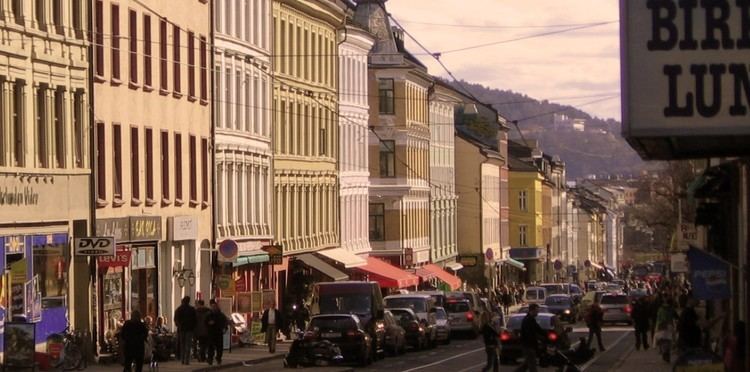Time zone CET (UTC+1) Area 4.75 km² | Population 43,961 (2009) | |
 | ||
Website bydel-grunerlokka.oslo.kommune.no | ||
Oslo nightlife gr nerl kka
Grünerløkka (alternative spelling: Grünerløkken) is a district of the city of Oslo, Norway. Grünerløkka became part of the city of Oslo (then Christiania) in 1858. Grünerløkka is a traditional working class district, but from the late 20th century a gentrification process has taken place in the area. Although it is located in the East End, it has a relatively high price level today compared to other East End areas.
Contents
Map of Gr%C3%BCnerl%C3%B8kka, Oslo, Norway
History
Grünerløkka was named after Friedrich Grüner who bought a mill in the area from King Christian V of Denmark in 1672 (the last element is the finite form of løkke f 'paddock'). During the 19th century, Grünerløkka became a working-class area. Several factories were placed here, because of the advantages of being located close to the Akerselva river. Christiania Seildugsfabrikk from 1856 and Aktieselskapet Herkules from 1898 were two of the factories established. Thorvald Meyer bought parts of the Grünerløkka area in 1861. He built the main street of Grünerløkka, now named for him Thorvald Meyers gate.
In 1866, Grünerløkka (Paulus parish) had a total population of 13600. In 1900 the number had risen to 22000. At that time, only 5 streets in Oslo had a population above 3000. Of these, three were located in Grünerløkka: Markveien, Thorvald Meyers gate and Toftes gate (note: gate means street in Norwegian).
In 1864, a square meter was priced at about 30 Norwegian shilling (the Norwegian monetary unit at that time). Selling of land property started the year after 1864, though. Even if the land owner, Thorvald Meyer, offered low-priced land, almost no-one bought any of it until after 1868.
The park square called Olaf Ryes plass has its name from general Rye. It was an open field well out into the 1880s. The field was bought by Oslo kommune from the Grüner family for 10 000 N.Kr. in 1883. A narrow diagonal street was built, which led from Markveien to Thorvald Meyers gate. It had a stopping point for horse and carriage at the middle point. This small piece of street, through what is now a pedestrian park square, remained until far out in the 1930s.
Sports
The neighbourhood has its own sports club, Grüner, which was founded in 1914 with ice hockey and football as the most important activities. Grüner Fotball plays its home games in Dælenenga idrettsplass and currently is part of the third division of the Norwegian football system. The ice hockey team plays the home games at Grünerhallen.
